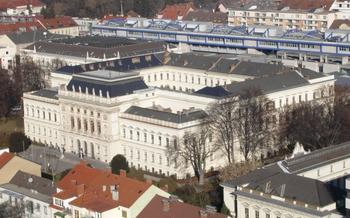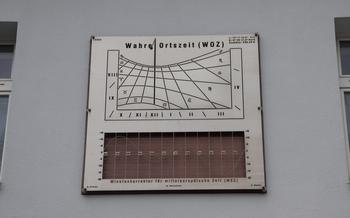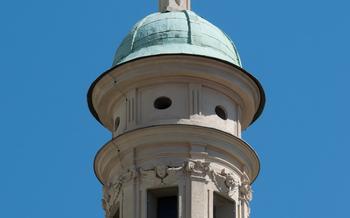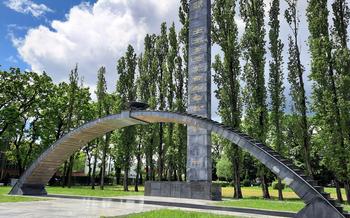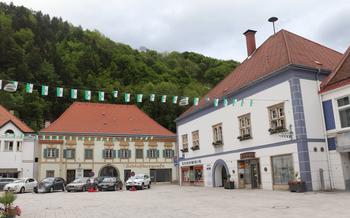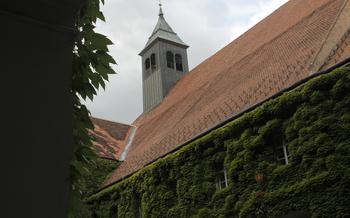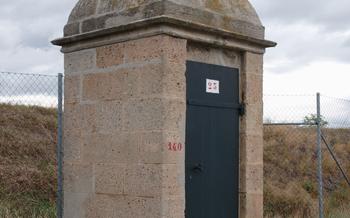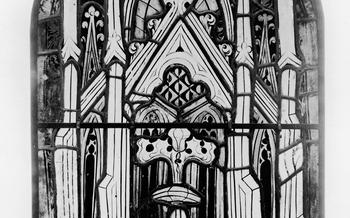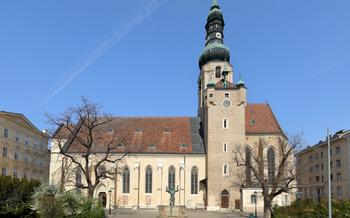
St. Barbara Church
- St. Barbara Church in Graz: A Gothic Masterpiece
- Location and Accessibility
- History and Background
- Architectural Highlights
- Religious Significance
- The Gothic Revival Style
- Visiting the Church
- Exploring the Interior
- Unique Features
- Attending Services
- Local Events and Festivals
- Nearby Attractions:
- Photography and Videography
- Accessibility for People with Disabilities
- Insider Tip:
St. Barbara Church in Graz: A Gothic Masterpiece
In the heart of Graz, Austria, stands a magnificent testament to Gothic Revival architecture - the St. Barbara Church. This iconic landmark, with its intricate details and soaring spires, is not only a religious edifice but also a symbol of the city's rich history and artistic heritage.
The church holds immense historical significance, dating back to the 13th century when it was first established as a small chapel dedicated to St. Barbara, the patron saint of miners. Over the centuries, the chapel underwent several transformations, culminating in the construction of the present-day church between 1446 and 1480.
Architecturally, St. Barbara Church is a masterpiece of Gothic Revival style, characterized by its pointed arches, ribbed vaults, and intricate stone carvings. The church's distinctive features include its twin spires, which rise majestically above the city skyline, and its elaborate facade, adorned with a profusion of sculptures and decorative elements.
Beyond its architectural significance, St. Barbara Church holds great religious importance for the Catholic community in Graz. Dedicated to St. Barbara, the church has been a place of pilgrimage and devotion for centuries. Pilgrims from near and far come to pay homage to the saint and seek her intercession. The church also plays a vital role in the local community, hosting regular masses, festivals, and events that bring people together in faith and fellowship.
Location and Accessibility
St. Barbara Church is conveniently located in the heart of Graz, just a short walk from various transportation hubs and attractions. Its exact address is Bürgergasse 2, nestled within the historic Lend district.
Public transportation options:
- Tram: Take tram line 1, 3, 6 or 7 to the "Lendplatz" stop, which is a 2-minute walk from the church.
- Bus: Several bus lines, including the 31, 32, 33, 40, 58, and 63, stop at the "Lendplatz" bus stop, offering easy access to the church.
- Train: Graz Central Station is approximately a 15-minute walk from St. Barbara Church.
Parking facilities:
Limited street parking is available in the surrounding area, but it can be challenging to find a spot during peak hours. Consider using public transportation or one of the nearby parking garages for a more convenient option.
Wheelchair accessibility:
St. Barbara Church is wheelchair accessible, featuring a ramp at the main entrance and an elevator to the upper levels. Designated seating areas are available within the church for individuals with disabilities.
History and Background
The origins of St. Barbara's Church in Graz can be traced back to the 13th century when a small chapel dedicated to St. Barbara, the patron saint of miners, was built on the site. In the 15th century, the chapel was expanded into a larger church, reflecting the growing importance of mining in the region. The construction of the current Late Gothic church began in 1438 and was completed in 146The design was influenced by the famous Viennese architect Anton Pilgram, who also worked on the Stephansdom in Vienna. St. Barbara's Church has undergone several renovations and restorations over the centuries, but it has retained its original Gothic character.
Throughout its history, St. Barbara's Church has played a significant role in the religious and cultural life of Graz. It was a popular pilgrimage site for miners and their families, who sought the protection of St. Barbara. The church also served as a venue for important religious ceremonies and festivals. In the 19th century, St. Barbara's Church became a parish church, further cementing its place in the local community.
Architectural Highlights
St. Barbara Church in Graz stands out for its unique design elements and impressive architectural features. The exterior boasts two striking towers that flank the main entrance, adding a touch of grandeur and symmetry to the facade. The spires atop the towers, reaching towards the heavens, create a dramatic silhouette that dominates the city's skyline.
The church's exterior is characterized by intricate stone carvings and delicate tracery, showcasing the skill and artistry of the Gothic Revival style. The facades are adorned with sculptures of saints, biblical figures, and mythical creatures, adding a layer of symbolism and religious significance to the building.
The interior of St. Barbara Church is equally breathtaking. The spacious nave, with its soaring vaults and ribbed arches, creates a sense of awe and reverence. The altar, a masterpiece of craftsmanship, features intricate carvings and gold leaf embellishments, serving as a focal point for religious devotion.
The stained glass windows are a highlight of the church's interior. Depicting scenes from the life of St. Barbara and other biblical stories, the vibrant colors and intricate details of the windows create a magical ambiance, transforming the interior space into a kaleidoscope of light.
Religious Significance
St. Barbara Church holds immense religious significance in Graz and beyond. It is dedicated to St. Barbara, the patron saint of miners, artillerymen, and all those who work with explosives. According to legend, St. Barbara was a young Christian woman who was martyred by her own father for her faith. Her story of courage and devotion has inspired countless people throughout history.
The church serves as a pilgrimage site for many faithful who come to pay homage to St. Barbara and seek her intercession. Devotees often leave offerings and prayers at the altar, asking for guidance, protection, and miracles. The church also holds regular religious ceremonies and festivals in honor of St. Barbara, attracting both local parishioners and visitors from afar.
As a significant Catholic landmark, St. Barbara Church plays a vital role in the local community. It is a place of worship, prayer, and spiritual reflection for many believers. The church's rich history and sacred atmosphere make it a beloved destination for those seeking solace, inspiration, and a deeper connection with their faith.
The Gothic Revival Style
St. Barbara Church stands as a testament to the Gothic Revival style, a 19th-century architectural movement that sought to revive the grandeur and spirituality of medieval Gothic architecture. Influenced by the writings of influential figures like John Ruskin and Augustus Welby Pugin, this style aimed to recapture the essence of Gothic cathedrals while adapting them to the needs and aesthetics of the Victorian era.
Key characteristics of Gothic Revival architecture include pointed arches, ribbed vaults, intricate tracery, and an emphasis on verticality. St. Barbara Church showcases these elements beautifully, with its soaring towers, slender spires, and ornate facades adorned with intricate carvings. The interior is equally impressive, featuring a vaulted nave, clustered columns, and graceful stained glass windows that bathe the space in colorful light.
Compared to other Gothic Revival buildings, St. Barbara Church stands out for its unique interpretation of the style. While many Gothic Revival churches were built in a neo-medieval style, St. Barbara incorporates elements of Romanesque and Byzantine architecture, creating a distinctive blend that sets it apart from its contemporaries. This eclectic approach showcases the creativity and innovation of the architects and designers who brought this remarkable church to life.
Visiting the Church
St. Barbara Church welcomes visitors with open arms, inviting them to explore its architectural wonders and religious significance. Embrace the opportunity to immerse yourself in the church's sacred atmosphere during its open hours. While admission is free of charge, donations are gratefully accepted to support the church's ongoing preservation efforts.
Guided tours are available to enhance your experience, providing insightful commentary on the church's history, architecture, and religious importance. Pre-booking is recommended to secure your spot, especially during peak tourist seasons. It is essential to adhere to the dress code and etiquette expected within a sacred space, ensuring a respectful and reverent atmosphere.
Exploring the Interior
Step inside the St. Barbara Church and prepare to be awed by its majestic interior. The nave, with its lofty ceiling and elegant arcades, creates a sense of awe and grandeur. The aisles, lined with slender columns and intricate carvings, lead you towards the altar, the focal point of the church.
Admire the intricately carved pulpit, a masterpiece of craftsmanship that seems to come alive with its delicate details. Take a moment to examine the religious artifacts adorning the church, each one telling a story of faith and devotion.
The stained glass windows, with their vibrant colors and intricate designs, are a true highlight. Each window depicts a different scene from the Bible, casting a warm and ethereal glow throughout the interior. Look closely and you'll discover hidden symbols and narratives woven into the stained glass, inviting you to delve deeper into the church's rich history and symbolism.
Unique Features
St. Barbara Church in Graz possesses several remarkable features that set it apart from other religious buildings in the city. One notable aspect is the intricate and detailed stone carvings adorning the exterior facades. These carvings depict biblical scenes, saints, and mythical creatures, adding a unique layer of artistry to the church's exterior.
Inside the church, visitors can admire the stunning stained glass windows, which depict various biblical stories and religious figures. The vibrant colors and intricate designs of these windows create a mesmerizing effect, transforming the interior into a kaleidoscope of light and color.
Another unique feature of St. Barbara Church is its crypt, which is located beneath the main altar. The crypt houses the remains of several prominent figures from Graz's history, including members of the Habsburg dynasty. Visitors can descend into the crypt to explore this fascinating underground chamber and learn about the rich history of the city.
Finally, the church's bell tower offers panoramic views of Graz and the surrounding countryside. Visitors can climb the tower's narrow staircase to reach the observation deck, where they can enjoy breathtaking views of the city's rooftops, the winding Mur River, and the distant mountains.
Attending Services
St. Barbara Church welcomes visitors of all faiths to attend its religious services. Masses are held regularly throughout the week, with special services and events scheduled on holidays and significant religious occasions. Visitors are encouraged to participate in the services, which are typically conducted in German, but English translations or international Mass booklets are available upon request.
For those interested in a more immersive experience, guided tours of the church are offered, providing insights into its history, architecture, and religious significance. During these tours, visitors can explore the church's interior, including the nave, altar, and stained glass windows, while learning about the stories and symbolism behind them. Guided tours are available in various languages and can be booked in advance to ensure a spot.
Attending services at St. Barbara Church is an opportunity to witness the vibrant Catholic community in Graz and experience the sacredness of this historic religious site. Whether visitors are seeking spiritual reflection, cultural enrichment, or simply a moment of awe and inspiration, they will find it within the walls of this magnificent Gothic Revival masterpiece.
Local Events and Festivals
The St. Barbara Church in Graz hosts several local events and festivals throughout the year, attracting visitors from near and far. Here are some highlights:
-
Christmas Market: During the festive season, the church square transforms into a charming Christmas market, filled with wooden stalls selling traditional Austrian delicacies, handmade crafts, and seasonal decorations. Visitors can sip on mulled wine, munch on gingerbread cookies, and soak up the holiday spirit.
-
St. Barbara's Day: On December 4th, the church celebrates the feast of its patron saint, St. Barbara. A special mass is held, followed by a procession through the streets of Graz. Locals and tourists alike gather to pay homage to the saint and seek her blessing.
-
Concerts and Exhibitions: The St. Barbara Church is renowned for its excellent acoustics, making it a popular venue for concerts and musical performances. Classical music concerts, choir recitals, and organ concerts are frequently held within the church walls, offering visitors a chance to experience the sacred space in a unique way. Additionally, the church occasionally hosts art exhibitions, showcasing the works of local and international artists.
-
Community Gatherings: The St. Barbara Church serves as a meeting point for the local community, hosting various events and gatherings throughout the year. These events include charity fairs, fundraising dinners, and community forums, providing opportunities for people to connect, socialize, and contribute to the well-being of the neighborhood.
Nearby Attractions:
In the vicinity of St. Barbara Church, a wealth of other captivating attractions awaits exploration. For those seeking further spiritual enlightenment, the majestic Graz Cathedral, a symbol of Gothic grandeur, stands tall, beckoning visitors to delve into its awe-inspiring interiors. History buffs can immerse themselves in the rich tapestry of the past at the Graz Museum, home to an eclectic collection of artifacts that narrate the city's fascinating story. Art enthusiasts will revel in the treasures of the Neue Galerie Graz, where modern and contemporary masterpieces grace the walls, igniting the senses and inspiring creativity.
A short stroll takes you to the vibrant heart of Graz, where shopping enthusiasts can indulge in a retail therapy session along Herrengasse, a charming street lined with elegant boutiques and inviting cafes. The aroma of freshly brewed coffee and delectable pastries wafts through the air, enticing passersby to savor a moment of tranquility amidst the urban buzz. For a taste of local cuisine, venture into one of the many traditional restaurants nestled in the picturesque alleys, where hearty Styrian dishes and refreshing beverages await.
Nature lovers can find solace and rejuvenation in the tranquil Stadtpark, an oasis of greenery situated just a stone's throw from the church. Amidst beautifully landscaped gardens, visitors can stroll along winding paths, admire the vibrant blooms, and bask in the tranquility of this urban sanctuary. For a more invigorating experience, embark on a scenic hike up the Schlossberg, a verdant hill that offers breathtaking panoramic views of Graz and its surroundings.
Photography and Videography
When visiting St. Barbara Church, it's important to be mindful of the sacred nature of the space. Photography is generally permitted, but visitors are asked to be respectful and avoid using flash or tripods. Taking photos during religious ceremonies or services is not allowed.
To capture stunning images of the church's interior and exterior, consider visiting during the day when natural light is most abundant. Early mornings or late afternoons often offer the best lighting conditions. Experiment with different angles and perspectives to showcase the church's unique architectural features.
Videography is generally not permitted within the church without prior permission. If you wish to film inside the church, it's essential to contact the parish office in advance and obtain the necessary authorization.
When taking photos or videos, be mindful of the privacy of other visitors. Avoid capturing people's faces or disturbing their religious experience. Always ask for permission before photographing or filming individuals, especially during services or ceremonies.
By following these guidelines, you can respectfully capture the beauty and significance of St. Barbara Church while preserving the sanctity of this sacred space.
Accessibility for People with Disabilities
St. Barbara Church welcomes visitors with disabilities and strives to ensure that everyone can enjoy their visit. Wheelchair accessibility is provided through ramps and elevators, allowing easy access to all levels of the church. Designated seating areas are available near the front for those who may need assistance or prefer to be closer to the altar. For the hearing impaired, assistive listening devices are available upon request, and sign language interpretation can be arranged in advance with the church office. Information about the church's history, architecture, and religious significance is also available in accessible formats such as Braille or large print. The church staff is always happy to assist visitors with disabilities, so please do not hesitate to ask for help if needed.
Insider Tip:
-
Timing Your Visit: For the best lighting conditions for photography, aim to visit the church during the golden hour, around sunrise or sunset. This will enhance the warm tones and textures of the architecture. To avoid crowds and capture the church's serene atmosphere, consider visiting during weekdays or off-season periods.
-
Hidden Gems: Explore the crypt beneath the church, which houses a collection of historic artifacts and artworks. Don't miss the intricate carvings and sculptures that adorn the exterior of the building, particularly the delicate tracery of the windows and the ornate portals.
-
Local Customs: When visiting the church, be respectful of the religious significance of the space. Dress modestly and avoid loud noises or disruptive behavior. If you witness a religious ceremony, observe quietly from a distance.
-
Culinary Delights: After exploring the church, indulge in the local cuisine at one of the nearby restaurants or cafes. Try traditional Austrian dishes such as Wiener Schnitzel, Tafelspitz (boiled beef), or Kaiserschmarrn (shredded pancakes) paired with a refreshing glass of Austrian wine.
